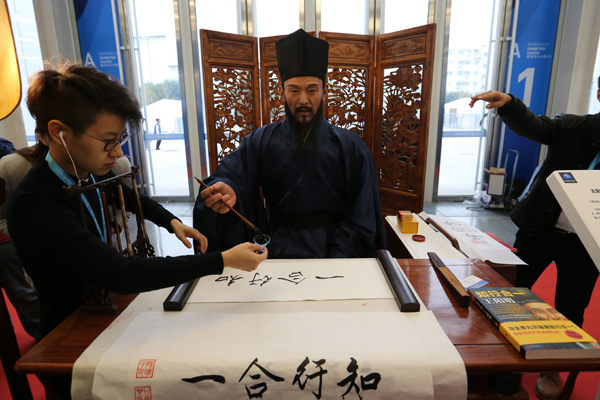Robots at center of China's big strategy to leapfrog its rivals
Updated: 2016-10-31 11:02
(China Daily)
|
|||||||||
 |
|
Visitors watch a robot perform calligraphy at a robot exposition in Beijing. [Photo by Wang Zhuangfei/China Daily] |
The Canbot can say its name, respond to voice commands and "dance" as it plays Michael Jackson's song Billie Jean. Other Chinese robots on display at the World Robot Conference can play badminton, sand cellphone cases and sort computer chips.
China is showcasing its burgeoning robot industry at the five-day exhibition in Beijing, part of a national effort to promote the use of more advanced technologies in Chinese factories and to create high-end products that redefine the meaning of "Made in China."
Apart from the so-called cool factor, China's sweeping plans to upgrade its factories and production lines depend on building and better using advanced robots. Automation is crucial for industries facing rising labor costs and slowing growth in the work force thanks to the "one-child" policy era and aging of the population.
Analysts say China will have to make big strides to leap ahead of Germany, Japan and other nations whose robots are generations ahead.
Infinities International Group, based in east China's Shandong, advertises its Canbot U-Partner as a service robot able to be programed to run errands in shopping malls, restaurants and banks. However it's modeled on the "Pepper" robot made by Japan's SoftBank.
Nearby at the conference, Peng Zhihui and Luo Binyi stood with "Ares"-a human-sized robot they designed which features exposed metal arms and hands and was produced with a wide range of uses in mind, from military to performing basic tasks at home.
Peng and Luo, both 24, developed the mannequin-like "Ares" while attending college in southwestern China's Sichuan province. A Shanghai investment company pitched in some funding.
"Many robots aren't very useful right now, but will show their true value when they are used in homes in the future," Peng said.
Thousands of factories in south China's industrial centers which long were manned by low-cost migrant workers, are now turning to robots. China has become the world's top consumer of industrial robots and will soon have the most commercial robots in operation of any country. Foxconn, the Taiwan company that assembles Apple's iPhones in the Chinese mainland, has installed 40,000 robots in its factories.
China made robotics a focal point of its recent "Made in China 2025" plan and has set national goals of producing 100,000 industrial robots a year and having 150 robots in operation for every 10,000 employees by 2020, a figure known as robot density. Currently, China ranks 28th in the world for robot density, behind Portugal and Indonesia. Chinese suppliers sold about 20,000 robots last year to local companies.
"There has never been such a dynamic rise in such a short period of time in any other market," the International Federation of Robotics said in an analysis of China's robot industry published earlier this year.
Steve Wyatt, head of sales and marketing for Switzerland-based ABB Robotics, said his company employs more than 1,600 people in China and has seen its sales in China grow by a factor of 50.
But the country remains behind in terms of the complexity of tasks Chinese-made robots can handle, Wyatt said.
Chinese appliance maker Midea Group recently announced it was purchasing almost all of German industrial robot manufacturer Kuka.
Wing Chu, a senior economist at the Hong Kong Trade Development Council, said the Chinese mainland would continue to seek foreign expertise to advance in robotics as part of a broader effort to transform its economy.
ASSOCIATED PRESS
Related Stories
The opening ceremony of 2016 World Robot Conference 2016-10-28 11:10
The Press Conference of World Robot Conference2016 Held in Beijing 2016-10-27 15:11
Humanoid robots shine at the World Robot Exhibition 2016 2016-10-22 14:42
2016 World Robot Conference kicks off 2016-10-21 09:38
Wonderful robot in the World Robot Conference 2016-10-28 11:10
Today's Top News
Email probe takes toll on Hillary's campaign: poll
Strongest quake in decades hits central Italy
EU, Canada sign landmark deals
Party ramps up supervision
Queen Elizabeth visits new town Poundbury
UK retailers catering for homesick Chinese
UK government opts for new Heathrow runway
China's business leaders optimistic about UK
Hot Topics
Lunar probe , China growth forecasts, Emission rules get tougher, China seen through 'colored lens', International board,
Editor's Picks

|

|

|

|

|

|







